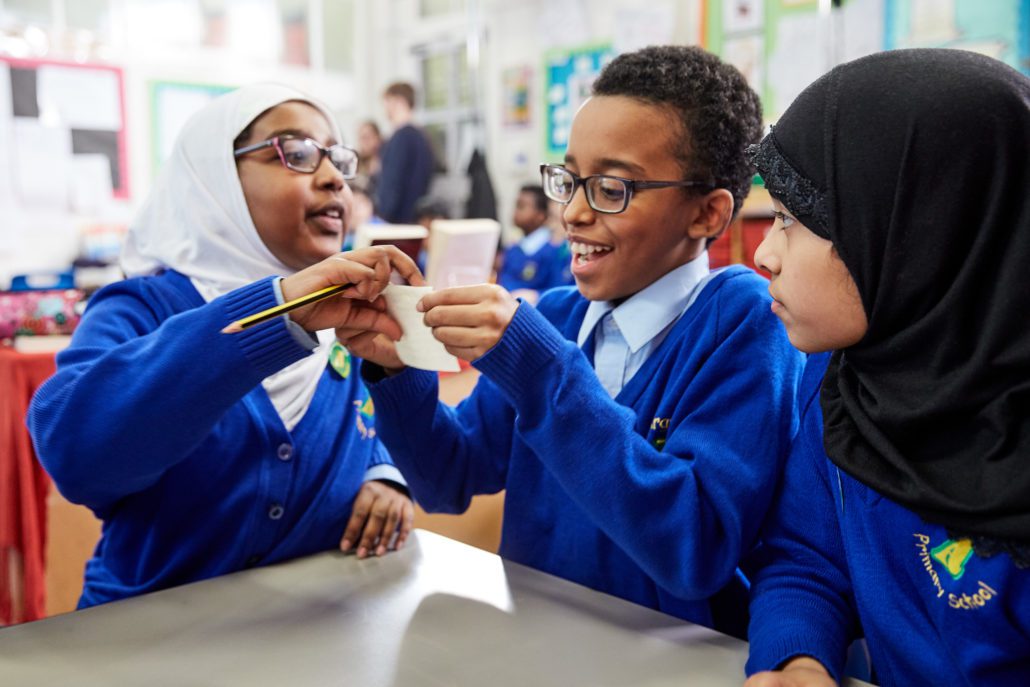

Children can be the most curious of creatures but how do we keep their curiosity going? How do we get them excited to ask questions and enjoy learning?

Mary Ellen McCarthy, CEO Lumen Learning Trust
Over the last 30 years of my career, I have had a number of roles, infant class teacher, junior class teacher, various subject leader roles, SENCo, Headteacher and now am CEO of a Multi Academy Trust and a National Leader of Education. This range of roles over the last three decades has enabled real insight into the ever-changing emphases for primary education resulting from shifts in government policy priorities in terms of curriculum. Science is arguably one of the areas that has been perhaps most affected by the apparently capricious nature of government policy priorities, quite often feeling like the poor relation of the ‘Core Subjects’ family.
It has troubled me for some time that the curriculum has increasingly felt narrow, in the ongoing drive for better outcomes in Maths and English. Running parallel to this concern is hearing teachers’ response to planning – evidently finding it a drudge and somehow disconnected to the time spent with the children. In my role as NLE, working alongside teaching teams in a range of schools, I’ve been taken aback about the number of times I have heard teachers say how much they like being with the children, but find the planning arduous. I just wonder how the intrinsic interest of the planning process has been lost. It appears that planning, assessing and teaching are seen as three separate acts – not one multifaceted process with a required interdependence on each other in order to enable effectiveness of the teaching and learning. My sense is the curiosity factor has somehow been lost in the process for our teachers. If our curriculum can harness that for our teachers, then surely the outcomes would be better for the children too?
For me, the narrowness of the curriculum and children’s consequent engagement with it, is clearly evidenced by the shift in pupil attitudes from Early Years through to Year 6. Here is my thinking: as a parent I spent what felt to be an inordinate amount of time with my toddlers while they were fascinated by the most (in my mind) uninteresting of things e.g. chewing gum stuck to pavements, bird poo, a cigarette butt and so on. We all appreciate the irony of the child who enjoys the box the toy comes in more than the toy itself. My question is what happens to that curiosity? Where does it go? What is our curriculum doing to harness that attribute – most importantly to keep our children on the edge of their learning competence, but also to keep our teachers interested too. We see it in good Early Years provision – children’s interests being used as a starting-point-vehicle to support their development in a range of other areas. However, as we go through the primary school ages, it can feel harder and harder to elicit the same levels of excitement in learning opportunities.
Dr. Matthew McFall, who describes himself as an ‘Agent of Wonder’, has researched a great deal into how the aspects of wonder and curiosity could be play a greater part in our provision. He makes reference to the need for “conation” in education – the need to get involved and do something; an aspect which perhaps we see in Early Years because of the nature of the provision, but is lacking as the curriculum moves through the primary years.
Susan Engel, in carrying out her research for “Children’s Need to Know: Curiosity in Schools” (2011) came across a teacher who she called Mrs. Parker. Mrs. Parker was teaching a science lesson to some 10-11 year olds. It was a practical lesson aimed at enabling the children’s understanding of forces. Engel observed the prescriptive nature of the instructions to the children, however when one group deviated from the instructions and genuinely did start to explore the attributes of the different parts of equipment, Mrs. Parker’s response was a degree tetchiness and frustration, commenting “OK, kids. Enough of that. I’ll give you time to experiment at recess. This is time for science.”
I certainly can relate to Mrs. Parker. I know I have been Mrs. Parker more than once. In the desire and anxiety about “getting through” the curriculum content, our commitment to primary pedagogy can be forgotten.
Curiosity has a particular role in the Science curriculum. Arguably this innate response to our world is in fact the beginning of the science disciplines. All the more concerning then, of what the marginalisation of this attribute in our curriculum could be doing to our children’s ‘whole’ development.
Ofsted’s London Regional Director, Mike Sheridan, stated “Good schools aren’t looking to see what Ofsted wants. They’re looking to see what their children need” (Twitter 23-1-18). It’s a very particular challenge to walk the very public tightrope of expectations re SATs, but I wonder if we school leaders ask ourselves often enough – what do our children need? I worry that by not harnessing such a fundamental human element of learning – curiosity – through our curriculum design, we are missing opportunities to offer our children a truly rounded education. It feels as if we are in danger of putting ourselves, and more importantly our children, in a binary decision-making process. EITHER we have a clearly-delineated subject framework which we teach to OR we have an integrated, linked curriculum which ensures the integrity of the subject disciplines isn’t compromised, but still makes meaningful links. I would suggest that to adopt the former, we are in danger of acting as mere ‘technicians’, defaulting to Locke’s tabula rasa approach. The latter is arguably braver but perhaps tunes in more effectively to our human condition. Maybe it’s time we stopped thinking about either/or and consider both? Maybe if we did that, we may surprise ourselves not just in the strength of the children’s outcomes in English and Maths but in other subjects too?
Either way, in answer to the question at the beginning, no I don’t think the curriculum killed curiosity, I think we did that to ourselves in our response to the imposition of a National Curriculum and associated assessment processes. Perhaps now, when HMCI Amanda Spielman is encouraging debate about curriculum design, we should grasp what opportunities we have to design a curriculum that offers our children what they need for future rounded success? In doing so we may not only strengthen our children’s outcomes across the curriculum areas, but also harness the innate creativity of our teachers and halt the growing sense of disenchantment which is all-too-often becoming a talking point about our profession.